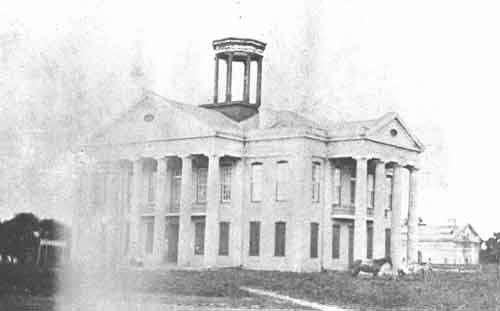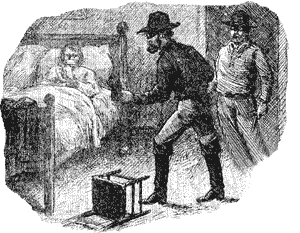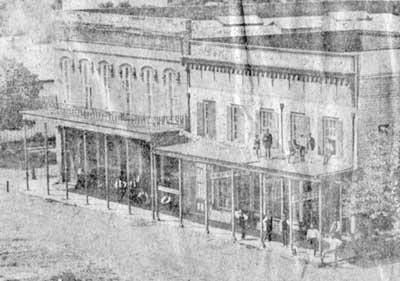"Raymond Years Ago"
By George W. Harper
Journalist - Editor - Owner Of Hinds County Gazette 1845-1883
A Series Published in the Hinds County Gazette, 1878-1879
From the Gillespie Collections edited by Pattie Adams Snowball and Rebecca Blackwell Drake
Home Page
Harper Arrives in Mississippi
Vicksburg & Meridian RR
Businesses in 1844
The Raymond Bar
Early Merchants
1844 Businesses
Seat of Justice
Cotton Industry
Early Churches
Establishment of Schools
John B. Peyton
Raymond Area Homes
Medicinal Resorts & Spas
The Mexican War
Early Churches
Early Schools
Raymond Female Institute
Raymond Military Institute
McNutt-Foote Debate
1844 Presidential Election
Local Elections of 1845
Literary Raymond
Raymond Fires
Old Log Jail
Death of Jos. Stewart
Murder of Benj. Sims
Duel Ends in Death
Raymond & Bolton RR
Harper Elected Mayor
Chaos at Oak Tree Hotel
Great Fire of 1858
Early Area Settlements
-
Amsterdam
-
Yeizer's Store
-
Newtown
-
Meridian Springs
-
Sturgiss Store
-
Dry Grove
-
County Line
Rev. Fisk's Biology Class
Fisk Charged with Fraud
Fleetwood Tragedy
Local Racetracks
Dignitaries Visit Raymond
Winning the Lottery
Fire Company No. 1
"Devoted & Valued Friend"
Tribute to Amos Johnson
Yellow Fever Strikes Raymond
Doctors Treating Victims
Cooper's Well
Mississippi Springs
Newspaper Entrepreneurs
Yankees Sack Gazette Office
Fate of Editorial Giants
Henry Clay Defeated in 1844
Stray Cats in Raymond
"A Remarkable Occurrence"
Blow That Punky Bell to Hell"
Isom Bldgs Destroyed
1851 Gubernatorial Election
Union Ticket Sweeps State
New Raymond Courthouse
Gibbs Building Rebuilt
Hinds Co. Poor House
Schools Struggle
Murder of Addie Owens
War comes to Raymond
The Battle of Raymond
Willie Foote Captured
Make-shift Hospitals
Yankees Occupy Raymond
Raymond Lodge No. 21
Odd-Fellows' Graveyard
Bolls Incarceration
Crimes Blamed on Whisky
Peyton's Willow Tree Prank
Politics in Raymond
Presidential Election 1860
Hinds Co. for Succession
Raymond Fencibles Organized
Churches Reorganize
The Clinton Riot of 1875
Why the Great Uneasiness?
Deaths of Sivley & Thomson
"Kill the Raymond Men"
Harrison Election
Political Gatherings
Event at Dupree's Grove
Presidential Election 1876
Governor Ames Impeached
Great Wrongs Investigated
Fight the Devil with Fire
Reconstruction Era
Harper Ends with Poetic Vision
Part XVI
Weldon Brothers Build New Courthouse
The county buildings in Raymond in 1856 were quite insufficient, and really quite discreditable to a county of the intelligence, population and wealth of Hinds, and in that year, we believe it was, a vote was taken, at a general election, to determine if the people would submit to a county tax for the erection of a new court house and jail.

The Raymond Courthouse was built 1857-1859 by The Weldon Brothers of Natchez who also built the Vicksburg Courthouse in 1858. The jail can be seen to the rear of the main structure. Of the jail Harper stated: "The jail however, was badly planned and badly constructed, and has been an eyesore for years past." |
With its usual public spirit and liberality, the county voted by a large majority in favor of a tax. Soon afterwards, the Board of Police contracted with the Weldons’ of Natchez for the building of the present court house and jail. The cost, first and last, about double the amount first contemplated, and the last payment upon them was not made until about four years ago. All will say today, who knows what the buildings cost, that the county paid very dear for the whistle, but at the time of completion all seemed satisfied, although a few insisted that George Weldon by all odds got the best of the bargain.
While the public buildings were in course of erection [1857-1859] “the great fire” occurred, and at once the Weldons contracted to rebuild for several parties, viz, G. W. Gibbs, J. W. Peyton, O. Y. Shearer, and perhaps one or two others, and buildings were soon erected for those gentlemen, which are now the prominent business houses of the town. The frame business house now owned by C. C. Heard, was erected at the same time by E.v. Seutter and the Scharffs, but T. I. Hunter, we think, was the contractor.
|
The Raymond court house is one of the finest public buildings in the State, and will, in all probability remain a perfect building for surging years to come. The jail, however, was badly planned and badly constructed, and has been an eyesore for years past. The probability is, we think, that it will be entirely reconstructed, or torn down, some day, and a credible jail as well as court house secured. It is a great pity that courthouses and jails are necessary. They are a great tax on the honest industry of the country. Many esteem them a luxury, perhaps, but they are a very expensive luxury, and could be entirely dispensed with if all lived strictly in conformity with the golden rule, “Do unto others as you would have others do unto you.” The time will come, no doubt in the world’s history, when they will be useless, but man must mend his ways much before that glad period can arrive, and our civilization and Christianity must be much improved.
Hinds County Poor House
Hinds county was without a Poor House for from 20 to 25 years, down to 1868, the paupers being so few in number that it was cheaper to board them out, by contract, than keep them together at the public expense. The army of paupers brought upon the county with emancipation, however, necessitated the purchase of a farm and the erection of a poor house in 1868. The poor farm is about two miles southeast of Raymond, and is conducted, we presume, with as much liberality as the public finances will permit and the ability of the tax-payers will allow. The few whites that are paupers in the South, as compared with the North, is especially the case in this county. Still our pauper list is large, and very expensive, but they are very nearly all colored, and receive as good treatment as the pauper whites at the North, notwithstanding the very great difference in the ability of the people to sustain purely philanthropic institutions.
Schools Struggle to Exists
No village ever labored harder to establish first class and permanent Academies and Institutes than Raymond has. In fact, it was a leading idea for many years with a large number of citizens, and time and money have been freely expended in behalf of various enterprises which failed just at the hour when it was though that success was achieved. A gentleman, still living in the State, expressed the opinion, we believe, that both parent and children were somewhat to blame for the failures of schools in Raymond. He related the following two accidents that occurred to his school within two weeks. The regular school house not being ready, he commenced his school in a private building, and in a day or two the house took fire, and but for timely and efficient labor, the entire building would have been destroyed. A week afterwards the school moved into the school-house, and, in a few days, that also took fire, and was nigh being destroyed. He says we have been informed that he was never assailed with fire elsewhere in all his experience in teaching. But this Raymond school was not as unfortunate as one a few miles in the country a few years ago. On one Saturday night all the children’s books were carried off; but new books were gotten the next week, and the school went on. On the next Saturday night all the seats were removed from the house and burnt; but new seats were obtained on Monday, and the young idea continued to shoot. On the next Saturday night the books, seats and school-house were all burnt; and that put an end to the jig.
The Murder of Addie Owens
The most brutal murder ever committed in Raymond or the vicinity, was that of Mrs. Addie Owens, some three miles from the village, in the month of May, 1874. And strangely enough, although committed in a very thickly settled neighborhood, and subjected to a prolonged and exhaustive investigation, the perpetrator of the great crime has never been legally reached or his guilt established.
 Mr. and Mrs. Owens, and their infant child, were sleeping, in their usual room
at their residence. At a late hour in the night, or towards morning, Owens,
according to his statement, heard some one at his corn-crib. He jumped from his
bed, seized his gun, and made for the corn-crib, which was no great distance
from the residence, going from the back door of the house. While on his way, one
or more men ran from the crib, passing in front of the residence, on whom Owens
fired, but without effect. Soon after he entered his house, and going to his
bed-room, found that, in his absence, some one had entered the room, and with an
ax, split Mrs. Owens’ head wide open, and that she was dying. She died, we
believe, without speaking.
Mr. and Mrs. Owens, and their infant child, were sleeping, in their usual room
at their residence. At a late hour in the night, or towards morning, Owens,
according to his statement, heard some one at his corn-crib. He jumped from his
bed, seized his gun, and made for the corn-crib, which was no great distance
from the residence, going from the back door of the house. While on his way, one
or more men ran from the crib, passing in front of the residence, on whom Owens
fired, but without effect. Soon after he entered his house, and going to his
bed-room, found that, in his absence, some one had entered the room, and with an
ax, split Mrs. Owens’ head wide open, and that she was dying. She died, we
believe, without speaking.
Such was Owens’ statement, and at once the neighborhood, with its utmost energy, went to work to find the guilty party. Jos. Gray, as Magistrate, brought before him every party against whom even the slightest suspicion could be made to rest, among them Owens himself. The investigation continued for a number of days and the evidence covered quires of paper. But no proof of a legal character was reached, or has been reached to this day.
The next winter Owens removed to Texas, and a year or two ago was killed, according to the newspaper account, in an altercation growing out of a difficulty which had its origin about the murder of Mrs. Owens.
All photographs, drawings and illustrations were edited into the series by Pattie Snowball and Rebecca Drake.
Copyright © 2008 Pattie Adams Snowball, James and Rebecca Drake
